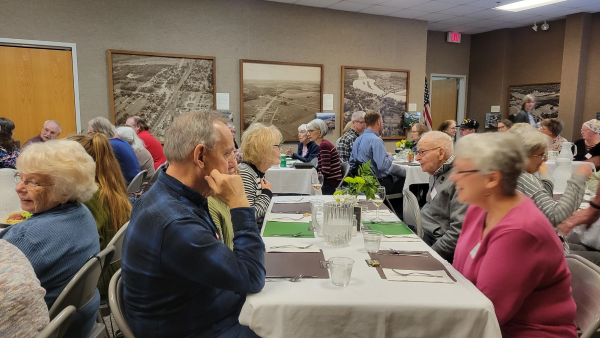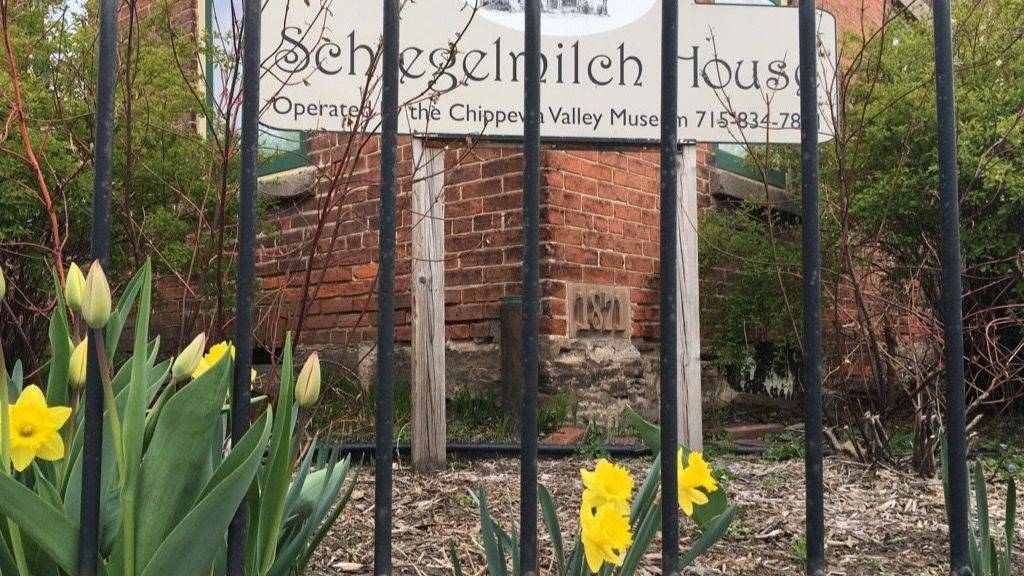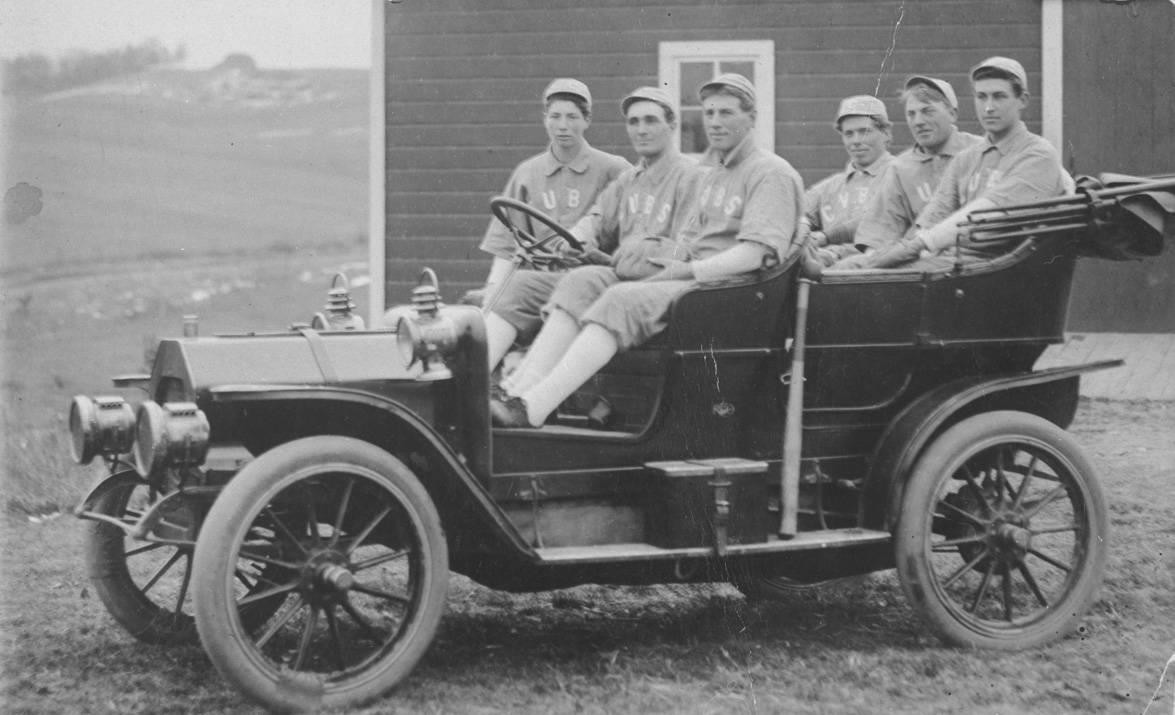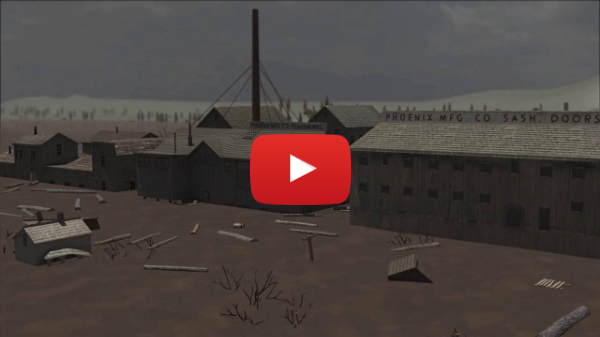|
| Museum Happenings | April 21, 2023 |
|
|
|
April 16-22, 2023 is National Volunteer Week, and April is National Volunteer Month. Museum volunteers greet visitors, clean public spaces, fix and build things, plant and weed the Schlegelmilch gardens, represent the museum at outreach events, conduct research, write articles, scan photos, catalog museum collections, install exhibits, lead tours, put artifacts away, work fundraising events, and much more. Hats off and three cheers to all volunteers who have ever served the Wisconsin Logging Museum and Chippewa Valley Museum. |  | The museum's annual Volunteer Recognition and Appreciation Dinner was held Monday, April 17. Volunteers had the opportunity to tour the Wisconsin Logging Museum as part of this event. Above - Lucy, a Certified Teen Guide, tries her hand at an activity in the Tall Tales Room. Below - a scene from Monday's dinner. |  | | Volunteers - By the Numbers(FY22 - October 1, 2021 through September 30, 2022) 200 CVM volunteers gave 5,231 hours, equal to 2.5 full-time positions.
57 first time-volunteers, most through the UWEC Circle C and Memorial High School Key Club
12 Volunteers gave 800 hours to build and install a 16' HO model train layout depicting downtown Eau Claire in 1933
14 docents (museum guides) helped lead 74 tours.
8 teens completed the Teen Guide program. 25 volunteers, mostly Kiwanis Club members, worked the four-day US Open Chainsaw Sculpture Championship THANK YOU! | | The Schlegelmilch Garden StoryWednesday May 4rd, 517 S Farwell St, 6:30- 7:30 pm
|  | Daffodils stand as the first springtime garden blooms at the Schlegelmilch House, about 2017 | The Schlegelmilch House has stood downtown since the 1870s, but the blooming garden there is a much newer feature. Join the volunteers who manage and maintain the garden at the corner of Lake and Farwell Streets for a program revealing original garden plans and the ongoing caretaking that has created this downtown centerpiece. Arrive early and enjoy a self-guided tour of the curated rooms in the house. Cost: $10 ($8 CVM Members).
CVM Members: Remember to "Logon" when registering to receive your $2 member discount on this program. For support with registration, call the museum or email Angela (a.allred@cvmuseum.com) | | Register for Program | |
|
|
|
Baseball Exhibits Coming Your WayOpening April 29 | .jpg) | | Learn More | Baseball diamonds have long served as a place for people to come together to express their cultural traditions. This 20-panel traveling exhibit uses bilingual text, video, and soundscape to reveal how generations of Latinos/as -- players, fans, owners, and managers- -- have helped make baseball the game it is today. | | Opening May 16Playball in Eau Claire | Baseball has been played in Eau Claire and the Chippewa Valley since the 1860s. Playball in Eau Claire delves into local baseball history and complements the traveling exhibit ¡Pleibol! In the Barrios and the Big Leagues. |  | |
|
| Members --
Save the Date! Enjoy a member-exclusive evening at Chippewa Valley Museum celebrating baseball history. Connect to our newest exhibits and enjoy ballpark-themed food, drink and activities. Members will receive an event invitation by email. |
|
| | Once again, thank you to all volunteers. I've worked at the Chippewa Valley Museum for 22 years and continue to be astonished, and humbled, by the depth and breadth of volunteer support -- everybody who works here is.
Peace,
Carrie Ronnander
Chippewa Valley Museum Executive Director | PS - Rapid snow melt and recent rains have made for some high-water levels in area rivers. The Chippewa River is supposed to crest this Saturday at just over 773 feet above sea level, the second time in a week it's been at this level. Minor flooding begins at 773. Those with long memories remember the Chippewa River floods of 1993, 1967, and 1941. 1884 takes the top prize in terms of financial, social, and physical impact. In downtown Eau Claire, the Chippewa River crested at an estimated 786 feet. To put that height in context, that's about even with the Grand Avenue walking bridge and twelve feet higher than this year's high-water mark. UW-Eau Claire intern Creighton Kahlenberg wrote about the 1884 flood in a recent Then and Now social media post. The post came out April 7, just before the river made its climb to minor flood stage. His post is below. |  | Then and Now - 1884 Flood, Grand Ave Bridge. Pictured are the remains of the Grand Ave bridge in Eau Claire after one of the worst floods the city has ever seen. The bridge was only four-years-old, the previous bridge having been washed out in a June 1880 flood. On September 10th and 11th in 1884, the city of Eau Claire experienced one of the most destructive floods in its history. With over 14 inches of rain falling in less than 24 hours, the Chippewa River rose a whopping 27 feet-- think 2 1/2 story building -- the highest depth ever recorded. The massive amount of flooding destroyed many local sawmill holdings north of Eau Claire. This released 400 million logfeet of logs down the Chippewa River. This cataclysmic event wipped out 19 of 20 bridges between Bloomer and Pepin, including the recently reconstructed Grand Avenue bridge. The High Bridge on the north side of town was the only one to survive. Eight feet of water flowed through downtown Eau Claire, leaving behind three feet of mud. More than 3,000 of Eau Claire’s 15,000 residents were left homeless. This disaster reached national The New York Times and Harper’s Weekly, both nation publictions, and word of the destruction spread across the country. The estimated damage within Eau Claire exceeded $4 million at the time ($133 million presently). Reconstruction of the Grand Ave bridge started immediately after the flood. Its hasty, and likely poor, reconstruction is probably why it was replaced 15 years later with the current bridge. -- Creighton, intern. #CVMThenandNow |  | In 2014, students in the UW-Stout Game Design & Development program designed a 3D video of the 1884 Flood for the museum's Changing Currents exhibit. They used flood photos and research in the museum's files to design the video. The video is still on display and a highlight of many a tour. Adam Zablocki, one of the video designers, posted the video online.
|
|
|
|
|